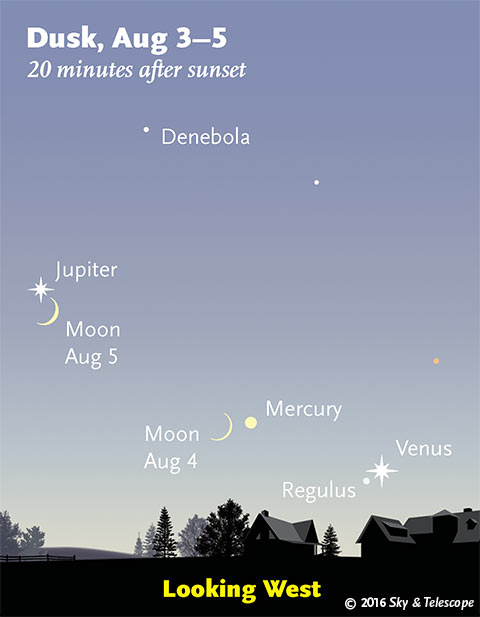
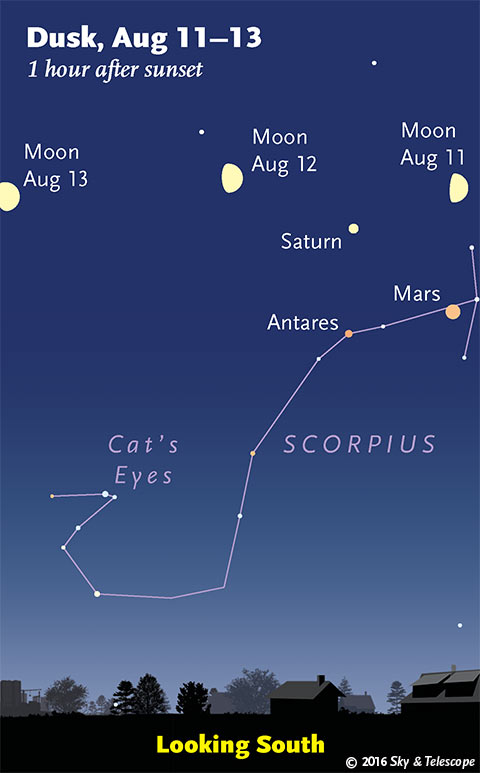
Friday, August 5
• The crescent Moon poses with Jupiter low in the west in twilight, as shown here.
• The Big Dipper hangs diagonally in the northwest after dark. From its midpoint, look to the right to find Polaris (not very bright) glimmering due north as always.
Polaris is the handle-end of the Little Dipper. The only other parts of the Little Dipper that are even modestly bright are the two stars forming the outer end of its bowl. On August evenings they're about a fist and a half (at arm's length) to Polaris's upper left. They're called the Guardians of the Pole, since they circle around Polaris all night and all year.
• Seen any Perseid meteors yet? The shower is due to peak late Thursday night the 11th (see below), but it's active at lesser levels for many nights before and several nights after. On the morning of August 3rd, writes Bill R. Smith of Choco, California, "I saw four Perseids in an hour," and on the morning of the 4th, "six in one hour. Looks like we will indeed have a good showing this time!" For now, there's no interfering moonlight.
Saturday, August 6
• Today is the midpoint of astronomical summer: halfway between the June solstice and the September equinox (even though August 1st, Lammas Day, is generally celebrated as the "cross-quarter" day). The exact midpoint of summer is at 2:28 p.m. Eastern Daylight Time (18:28 UT).
• Accordingly, the "Spring Star" Arcturus now shines only moderately high in the west after dark, heading down — while the Great Square of Pegasus, emblem of autumn, is low in the east coming up. Look for the Great Square balanced on one corner. It's about 15° on a side, larger than your fist at arm's length.
Sunday, August 7
• As the stars come out, look left of the Moon for Spica, and right or lower right of the Moon for fainter Gamma Virginis (Porrima).
Monday, August 8
• In the deepening twilight, Spica twinkles below or lower right of the Moon.
• Mars is passing 0.9° beneath Delta Scorpii (Dschubba), the brightest star in the head of Scorpius, this evening and tomorrow evening.
Tuesday, August 9
• Have you seen Venus yet? It's slowly beginning a long and eventually spectacular evening apparition that will run all the way through the end of the coming winter. About 20 minutes after sunset, start by spotting Jupiter low due west through the twilight. Venus shines to Jupiter's lower right by 18°, about two fist-widths at arm's length.
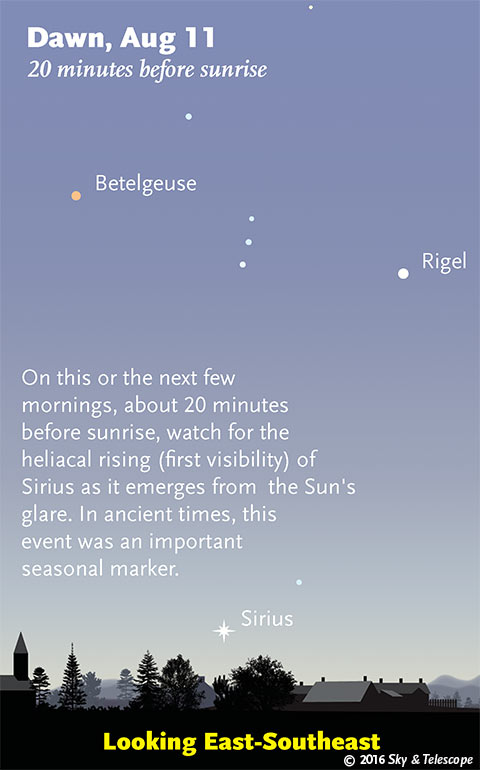
Wednesday, August 10
• The Perseids are ramping up tonight! See Thursday below.
• As twilight fades away, Vega shines near the zenith (if you're in the mid-northern latitudes), and Arcturus shines in the west.
A third of the way from Arcturus up to Vega, look for Corona Borealis, the Northern Crown, with its one modestly bright star: Alphecca or Gemma.
Two thirds of the way from Arcturus to Vega is the dim Keystone of Hercules, with the 6th-magnitude globular cluster M13 in its western side.
Thursday, August 11
• The Moon this evening forms a tilted diamond shape with Saturn, Mars, and Antares, as shown in the second panel above. The shape of the diamond will depend on your time and place.
• The annual Perseid meteor shower should peak late tonight. The Moon, just past first quarter, sets around 1 a.m., leaving the sky dark for the best meteor-watching hours leading up to dawn. Find a dark spot, wrap up in blankets or a sleeping bag, lie back in a reclining lawn chair, and gaze at the stars overhead. Be patient. If this is a typical year you might see a meteor a minute on average, depending on your sky's light pollution.
But this year meteor scientists are predicting a chance of an especially strong shower, due to Jupiter slightly perturbing some of the Perseid meteoroid stream 16 months ago. That periodic event has been associated with especially good Perseid showers in the past; see the August Sky & Telescope, page 48, or the version online: Will You See a Bumper Crop of Perseid Meteors?. And photographers: see Capturing the Perseids: How to Photograph a Meteor Shower by astrophoto expert Jerry Lodriguss.
Follow the progress of the shower at the International Meteor Organization's site, imo.net. The activity curve there is updated as meteor observers around the globe report their counts made by standardized methods.
Friday, August 12
• This evening, the waxing gibbous Moon looks down on the Saturn-Mars-Antares triangle from the upper left (as shown in the second panel above).
• The Perseids continue late tonight, a day after their nominal peak. Now the Moon doesn't set until about 1:30 or 2 a.m. local daylight saving time (Saturday morning).
Saturday, August 13
• This evening, look very high to the upper left of the Moon — by about four fists at arm's length — for Altair shining brightly. A finger-width above it is its eternal background companion, Gamma Aquilae or Tarazed, magnitude 2.7, a K3 orange giant. Can you see the color of a star this dim without optical aid?
Left of Altair by about a fist-width is Delphinus, the Dolphin, leaping leftward. Can you see it through the moonlight? Its brightest stars, in the Dolphin's back and tail, are magnitudes 3.6, 3.8, and 4.0.
_________________________
Want to become a better astronomer? Learn your way around the constellations! They're the key to locating everything fainter and deeper to hunt with binoculars or a telescope.
This is an outdoor nature hobby. For an easy-to-use constellation guide covering the whole evening sky, use the big monthly map in the center of each issue of Sky & Telescope, the essential guide to astronomy.
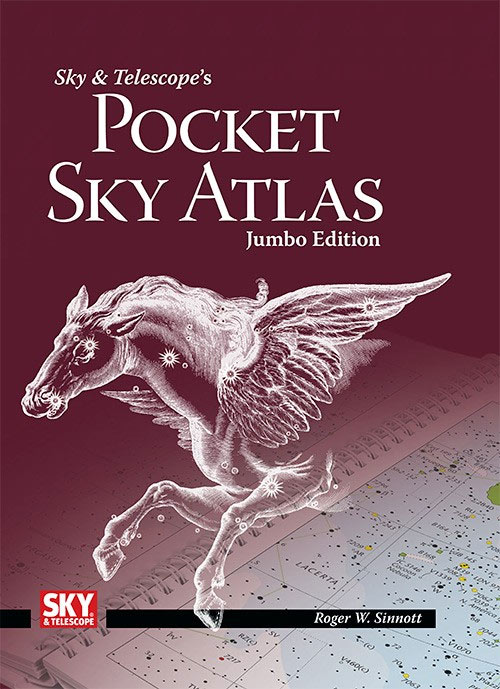
Once you get a telescope, to put it to good use you'll need a detailed, large-scale sky atlas (set of charts). The basic standard is the Pocket Sky Atlas (in either the original or new Jumbo Edition), which shows stars to magnitude 7.6.
Next up is the larger and deeper Sky Atlas 2000.0, plotting stars to magnitude 8.5, nearly three times as many. The next up, once you know your way around, is the even larger Uranometria 2000.0 (stars to magnitude 9.75). And read how to use sky charts with a telescope.
You'll also want a good deep-sky guidebook, such as Sue French's Deep-Sky Wonders collection (which includes its own charts), Sky Atlas 2000.0 Companion by Strong and Sinnott, or the bigger Night Sky Observer's Guide by Kepple and Sanner.
Can a computerized telescope replace charts? Not for beginners, I don't think, and not on mounts and tripods that are less than top-quality mechanically (meaning heavy and expensive). And as Terence Dickinson and Alan Dyer say in their Backyard Astronomer's Guide, "A full appreciation of the universe cannot come without developing the skills to find things in the sky and understanding how the sky works. This knowledge comes only by spending time under the stars with star maps in hand."
This Week's Planet Roundup
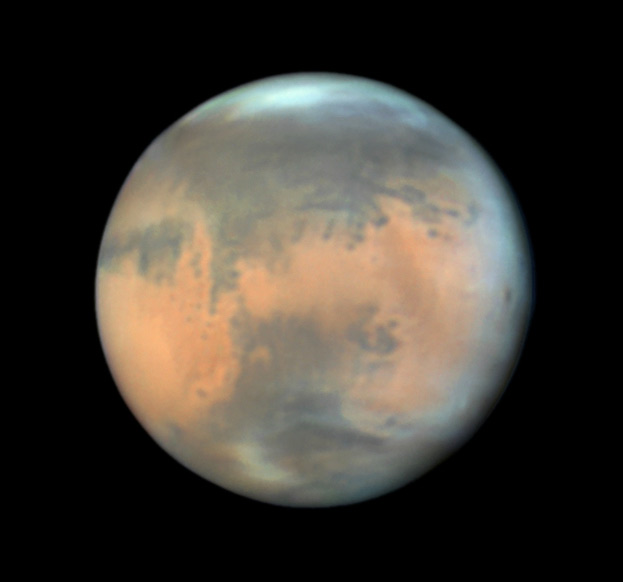
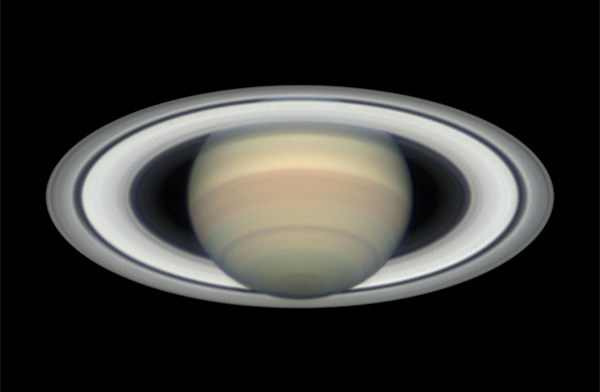
Mercury and Venus are very low in bright twilight. About 20 minutes after sunset, look for Venus slightly to the right of due west. Binoculars or a wide-field telescope will help. Don't confuse Venus with Jupiter off to its upper left.
Then try to spot fainter Mercury 9° to Venus's left or upper left (almost a fist-width at arm's length). Venus is magnitude –3.8. Mercury is only 1/35 as bright at magnitude 0.0.
Mars (magnitude –0.7, in the head of Scorpius) is moving rapidly eastward (leftward) against the stars, back toward Saturn and Antares. The three form an ever-shrinking triangle in the southwest at nightfall. The triangle will turn into an almost straight, vertical line on August 23rd and 24th, when Mars slingshots between the other two.
Mars passes 0.9° below Delta Scorpii (Dschubba) on August 8th and 9th. In a telescope this week, Mars is 12 arcseconds in diameter and clearly gibbous.
Jupiter (magnitude –1.7, at the head of Virgo) is low due west in twilight, well to the upper left of Venus. The gap between them shrinks by 1° per day: from 21° on August 6th to 14° on August 13th.
Saturn (magnitude +0.4, in southern Ophiuchus) shines in the south at dusk, 6° above fainter Antares and a little farther than that upper left of brighter Mars.
Uranus (magnitude 5.8, in Pisces) and Neptune (magnitude 7.8, in Aquarius) are well up after midnight, in the east and southeast respectively. Info and finder charts.
__________________________
All descriptions that relate to your horizon — including the words up, down, right, and left — are written for the world's mid-northern latitudes. Descriptions that also depend on longitude (mainly Moon positions) are for North America.
Eastern Daylight Time (EDT) is Universal Time (UT, UTC, or GMT) minus 4 hours.
__________________________
"Rational and innocent entertainment of the highest kind."
— John Mills, 19th century Scottish manufacturer and founder of Mills Observatory, on amateur astronomy.
 2
2








Comments
mary beth
August 5, 2016 at 2:55 pm
Was blessed to see Venus last evening - I was surprised to see it because it was right around sunset, before civil twilight. It stood out beautifully in the orange tinted west-northwestern Sky. The sliver of a young moon added to the beauty! Hoping for clear skies across the country for all to enjoy the many August astronomical events!
You must be logged in to post a comment.
August 10, 2016 at 4:20 pm
Thanks a bunch Alan for doing this.
- Doug
You must be logged in to post a comment.
You must be logged in to post a comment.